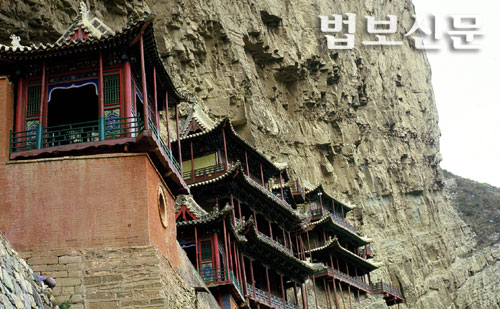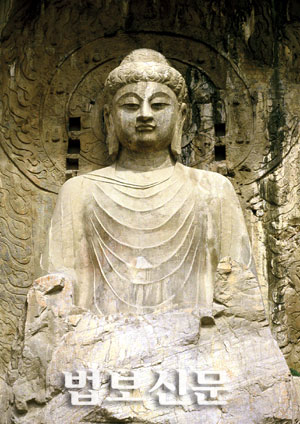종교 금지 정책에도 불자 여전히 1억 육박
“경제 성장 속 전통 가치 보루는 불교될 것”
 |
| <사진설명>공중에 떠있는 사찰로 유명한 현공사(懸空寺) |
약 30여 개 국 출신의 불자들이 최근 ‘세계불교포럼’을 위해 중국을 방문했다. 이번 ‘세계불교포럼’은 공산 국가인 중국이 개최한 최초의 종교적 모임이라고 한다. 수 백명의 학자들과 남녀 스님들이 이 기념비적인 행사를 위해 항주(杭州) 시에 도착했다. 하지만 유명 종교 지도자들 중 단 한 분만이 이 행사에 참석할 수 없었다고 한다. 달라이 라마께서 초대 받지 못하신 것이다. 이는 중국 정부가 아직도 달라이 라마를 분리주의자로 간주하고 있기 때문이다. 중국 공산당에서 직접 선택한 티벳 출신의 종교적 지도자인 판첸 라마(Panchen Lama) 걀첸 노르부(Gyaltsen Norbu)만이 대신해서 모임에 올 수 있었고 그가 이 회의에서 표면상의 대표 역할을 맡았다. 하지만 그는 개회식이 열리는 동안 각 나라 불교를 대표하여 참석한 사람들이 그에게 인사조차 하지 않는 태도에 꽤 놀랐다고 한다. 우리는 여기서 달라이 라마께서 직접 선출하신 판첸 라마가 갑자기 실종되었으며 중국 어딘가에 가택 연금이 되어있을 거라고 공공연히 알려져 있다는 사실을 기억해야 할 것이다. 중국 정부는 1995년 달라이 라마께서 지명하신 판첸 라마 대신 걀첸 노르부를 판첸 라마로 임명하였다.
중국에는 약 1억에 달하는 불자들이 살고 있는데 이는 전 세계 불자인구의 8퍼센트에 해당된다. 공식적으로 무신론을 추종하는 공산주의는 모든 종교 행위에 대하여 강력한 통제를 행하고 있으며 공권에 대한 모든 가능한 도전 자체를 두려워하고 있다. 종교적 행위는 단지 정부에서 운영하는 단체를 통해서만 허용이 된다. 많은 남녀 스님들이 달라이 라마에 대한 숭배심을 가졌다는 이유만으로 감옥으로 보내졌다. 기타 다른 종교를 추종하는 사람들 또한 오랜 감옥행을 견뎌내야만 했다. 중국은 달라이 라마가 사흘간에 걸쳐 열리는 포럼의 화기애애한 분위기를 깨드리길 원하지 않는다고 했다. 중국 정부 내 종교사무소 부 대표인 퀴시아오페이 (Qi Xiaofei)씨는 “달라이 라마는 중국을 산산조각 내고자 하며 서로 다른 민족들 간의 조화를 깨트리는 고집쟁이 분리주의자에 불과하다. 이에 반해 중국 정부는 바티칸처럼 종교적 단체와의 관계 개선을 위해 많은 노력을 기울이고 있다”. 베이징 정부는 또한 항주에서 열리는 이번 모임을 통해 우리가 점점 더 종교적 자유에 관대해지고 있다는 것을 보여줄 수 있기를 바라고 있다”고 말했다.
중국의 주요 종교는 불교, 도교, 기독교 그리고 회교이다. 공산주의가 중국을 지배한 지난 57년간 종교 집단에 속한 수백만 명의 중국인들은 중국 역사의 그 시대에서도 찾아볼 수 없을 정도의 엄청난 인권을 유린당하고 억압받으며 지내야 했다. 이런 종교 집단들이 처형된 기록만도 수두룩하다.
고대 중국의 문화는 사회의 모든 계층에 속하는 사람들이 지닌 신념에 그 토대를 두고 있다. 도교는 고대 탄트릭 파에서 나온 분파였다. 불교가 중국 사회에 뿌리를 내리기 시작한 것은 2000여 년 전으로 알려져 있다. 유교가 자리를 잡으며 중국인들은 도덕적 체계와 윤리적 가치, 영적인 추구를 매우 중요시 했다. 종합적으로 살펴볼 때, 이러한 가치관은 중국 사회에 굳건한 토대, 평화와 조화를 가져다주었다. 원래 서양에서 시작된 철학인 중국 공산당(CCP)의 이념은 전통적인 중국인들의 신념과는 정반대의 사상이다. 중국 공산당은 무신론, 즉 신이 존재하지 않으며 부처님도, 도교도, 또 그 어떤 종교도 존재하지 않는다고 강력히 주장한다. 그들의 눈에는 종교 집단들이 그들 공산당의 독재체재를 방해하며 중국 내 공산주의의 타당성에 도전하는 주요 장애물로 비추어지고 있는 것이다. 중국이 공산주의자들의 손에 넘어간 후, 그들은 중국의 전통 사상과 종교의 뿌리를 뽑아내기 시작했다. 사찰을 파괴하고 불상을 태웠으며 남녀 스님들로 하여금 속세로 돌아갈 것을 강요했다. 문화 혁명이 일어난 10년 간 상황은 점점 더 악화되어갔다. 그나마 남아있던 전통 종교와 사상들이 재앙적인 파괴를 겪어야만 했다. 예를 들어, 베이징 근처 이화원(拗和園)의 ‘장수 언덕’이라고 불리는 곳에는 아름답게 조각된 1000여 점의 불상들이 있었다. 문화 혁명 기간 동안 이 불상들은 공산당 요원들에 의해 파괴되었고 현재는 아무것도 남아 있지 않다.
이런 눈에 보이는 물질적 파괴 말고도 중국 공산당은 종교 조직 밖에서 직접 침투하거나 아니면 몰래 집단 내부로 들어가서 하나씩 파괴해가는 교묘한 방법으로 종교 집단을 탄압해왔다.
공산 중국 역사 뒤에 숨겨진 이야기들은 너무나도 비극적이지만 이런 사실들이 유럽 사회와 자유 세상에 거의 알려지지 않았으며 급성장하는 중국 경제를 이용하여 사업적 계약을 얻어내는데 혈안이 된 우리는 인간이 누려야만 하는 권리가 유린당하는 사태 앞에서 눈을 감아버리고 말았다. 사람들은 히틀러에 의해 죽임을 당한 8백 만 명의 유대인들은 잘 기억하지만 중국 공산당 정권하에서 8천만의 착한 사람들이 죽임을 당했으며 고문으로 죽어갔고 원인 모를 이유들로 죽어갔다는 사실은 종종 잊는 경향이 있다. 이 8천만이라는 숫자는 1차 세계 대전과 2차 세계 대전을 합친 사망률을 훨씬 넘어서는 숫자이다. 많은 사람들은 왜 중국 공산당이 이 ‘평화의 시대’에 그 많은 중국인들을 죽였으며 종교 집단에 속한 사람들은 왜 그런 야만적인 처형을 받았는지 의아해 한다.
 |
| <사진설명>위용을 자랑하는 용문 석굴의 불상은 중국인들의 심오한 종교적 신념과 불교가 중국 문화에 끼친 영향력을 대변하고 있다. |
불교는 중국에 깊은 뿌리를 내리고 있다. 또한 불교는 철학, 도덕 체계, 문학, 시(詩), 조각, 서화(書畵) 등, 중국 문화의 모든 분야에 다양한 측면으로 영향을 주어왔다. 중국인들의 삶과 사고방식에 미친 불교의 영향은 어마어마하다. 불교는 중국 특유의 요소들을 모두 흡수했을 뿐만 아니라 중국의 문화를 한 단계 높은 경지로 올려놓는데 큰 역할을 했다. 불교는 또한 중국인들에게 깊은 종교적 믿음과 심오한 신념을 가져다주었다. 이러한 믿음은 운강석굴(雲崗石窟)이나 용문석굴(龍門石窟)에서 잘 표현되어 있다. 한마디로 말해 불교는 중국 문화에서 절대 떼어낼 수 없는 필수 요소인 셈이다. 공산주의 정책은 중국에서 사라질 것이며 (아마 우리가 생각하는 것 보다 더 빨리 사라질 수도 있다) 동양의 종교적 가치를 토대로 한 새로운 사회가 중국인들을 억압과 탄압이 존재하지 않는 새로운 시대로 이끌 것이다.
국제칼럼니스트
China
From Communism to Buddhism
Buddhists from more than 30 countries recently visited China for the World Buddhist Forum, communist China’s first international religious gathering. Hundreds of scholars, monks and nuns gathered in the eastern city of Hangzhou for this memorable event. Only one prominent Buddhist leader was absent. The Dalai Lama was indeed not invited by the Chinese government which still considers him as a separatist. The Tibetan spiritual leader was however replaced by the official choice of the Communist party, the Panchen Lama Gyaltsen Norbu who was supposed to be the figurehead of the conference. He was however shunned by most of the delegates who made no efforts to greet him during the opening ceremony. One should not forget that the Dalai Lama had nominated his own Panchen Lama who has since disappeared and is believed to be under house arrest somewhere in China. The Chinese government appointed instead Gyaltsen Norbu in 1995.
China has about 100 million Buddhist (8% of the world Buddhist population). The officially atheist communist party keeps a tight control on all religious activities, fearing a possible challenge to its authority. Worship is only allowed through state-run organizations. Many monks and nuns have been jailed for their loyalty to the Dalai Lama. Followers of other religions have also received long prison sentences. China claims that it did not want the Dalai Lama to disharmonize the four-day forum. Qi Xiaofei, Vice-director for religious affaires said that “the Dalai Lama is a stubborn secessionist who has tried to split his Chinese motherland and break the unity among different ethnic groups”. “On the other side, the Chinese government is trying to improve relations with religious establishments like the Vatican. Beijing is also hoping that the meeting in Hangzhou will show that the Chinese government is easing religious freedom.
The main religions in China include Buddhisism, Taoism, Christianism and Islam. In the past 57 years of Communist rule in China, millions of members from religious or spiritual groups have faced the most serious violations of human rights and a suppression which is unequalled in Chinese history. The persecution of each of these groups could fill volumes.
The ancient Chinese culture was primarily based on the faith of people from all walks of life. Taoism was an offshoot of the old Tantric cult. Buddhism started penetrating Chinese society less than 2000 years ago. Together with Confucianism, they offered a very stable moral system, ethical values and a spiritual; quest. Collectively they provided the basis for sustainability, peace and harmony of the Chinese society. Originating from the West, the philosophy of the Chinese Communist Party (CCP) totally contradicts Chinese culture and beliefs. The CCP believes in atheism, namely no God, no Buddha, no Tao, no spirituality. In their eyes, the religious groups are major obstacles to the party’s dictatorship and a challenge to its legitimacy. Ever since the CCP tool control of China, it started to root out traditional religions and beliefs. It also destroyed temples, burned sculptures and forced monks and nuns to return to secular life. During the 10 years of Cultural Revolution, things became even worse. What was left of the traditional religions and belief systems experienced a catastrophic destruction. For example, there were 1000 beautiful Buddha statues on the Longevity Hill in the Summer Palace near Beijing. During the Cultural Revolution, the red guards destroyed them all, leaving nothing.
In addition to physical damages, the Chinese Communist Party had a special way to destroy religions by infiltrating them directly and subverting them from inside. In the mid 70s, the Vice President of the Buddhist Association of China, Mr. Zhao Puchu, was found to be a CCP member and an atheist.
The stories behind Communist China’s history are extremely tragic and rarely known to the European society and the free world which prefer to close their eyes on the terrible abuse of human rights in order to reap the fruits of their business deals in a booming Chinese economy. People forget that, under the rule of CCP, 80 million innocent Chinese were killed (Hitler massacred 8 million Jews), tortured to death or died of unnatural causes. This number exceeds the total deaths of World War Ⅰ and World War Ⅱ combined. Many wonder why the CCP has killed Chinese on such large scale during “peace” time and why it is continuing its brutal persecution against religious and spiritual groups.
Buddhism is deeply rooted in the soil of China. It has exerted different degrees of influence on all aspects of Chinese culture, such as philosophy, morality, literature, poetry, sculpture, painting and architecture. The influence of Buddhism on Chinese life and thought has been tremendous. Buddhism not only absorbed Chinese indigenous elements but also greatly promoted and elevated Chinese culture to new heights. Buddhism also brought to the Chinese a deep religious feeling and profound faith which inspired the great works of art such as those found in Yangang Cave and Longmen Grottoes. In a word, Buddhism has become an inseparable part of China’s culture. The communist doctrine is bound to disappear from China (maybe sooner than we think) and a new society based on Eastern spiritual values will certainly usher the Chinese people into a new era where oppression and suppression will disappear forever.

